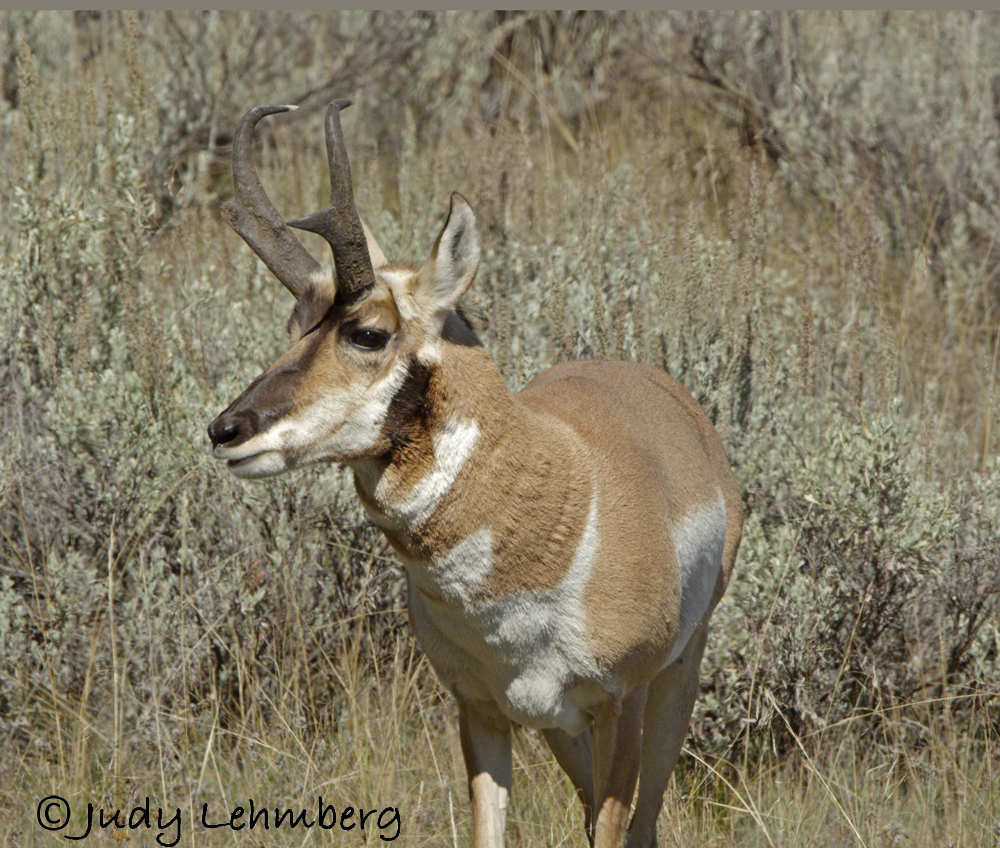

Pronghorn antelope don’t get a great deal of attention in Yellowstone. I guess they are over-shadowed by the more numerous bison and elk, but they really are remarkable animals in a number of ways. They are not true antelope, that is they are not related to the Old World impala, and the many other species of antelope in Africa and Asia. In fact they are in their own family, Antilocapridae, and they are the only living member of that family.

Pronghorn can run up to at least 60 miles per hour, faster than any other land animal except the cheetah and the fastest land animal in North America. On the face of it that doesn’t make much sense. If they want to avoid their predators they only have to run faster than wolves, mt. lions, bobcats, and coyotes. It begins to make sense however when you consider that cheetahs evolved in North America and preyed on pronghorns. The cheetahs in North America went extinct but the pronghorns are ready for them if they ever come back.

When pronghorn go into rut it is not as noticeable as the elk. They don’t bugle and they are more subtle in their actions. But they still mean business. The male pronghorn in the photo below is corralling 3 youngsters and an adult female.

In the following photo all of these female pronghorns “belong” to the male in the upper left of the photo. It wasn’t even obvious he was controlling them until they got too far away from him and then he went after them and herded them back. He had one of the largest groups of females I have ever seen. (There are a few females not in this photo over to the right.)

The young pronghorns in the following two photos were doing something I never totally understood. There were several of them but only two are visible in theses pictures. Look at the pronghorn on the right in the first photo. After she put her foot on the rock she rolled the rock towards her and then sniffed around it and licked it a little.

As she began to move the second rock the other pronghorn got interested. She pawed the rock until it looked like she had it in what she thought was the perfect position. Then both pronghorns licked the rock. I can only guess they were trying to get minerals but most of the animals I have seen do that go to clay licks. This was solid rock. If anyone has any idea what they were doing I would love to hear it.









I love the Pronghorn, too. Very interesting how they can continue running for long distances. Cheetah’s may be faster, but they peter out quick.
Interesting about the rocks. I did see this quote: Antelope and other wildlife supplement their diet by licking the sedimentary rock especially during winter, when wild grasses have less nutrition. It’s from a publication called Salt Lick at Wind Cave (South Dakota Magazine).
Interesting about the rocks and I, too, love to hear your details in the stories. And, your sense of humor about pronghorn being ready for the cheetahs if they ever come back. Maybe the US government should reintroduce them so the hunters can kill them too. Oh, that was kind of snarky but it is hard to understand some things.
I love the facts you put with your posts. I have to say that this past June I visited Yellowstone and one of the highlights was watching a pronghorn chase for about 45 minutes and that was after we drove up on it. Tongues were hanging but either would give up. They were doing loops through a little valley in which we were looking into so perfect viewing of 90% of the racetrack! With grizzlies, black bear triplets, elk, bison, bighorn and all things Yellowstone we saw I was glad to say pronghorn gave me a great memory from this trip. Love these guys! http://flyingturkey.smugmug.com/Other/i-v4vFVmQ
I love them too Margie. One of the facts I didn’t include was what you observed. They are not only fast they can keep it up for long periods of time. What we see as their tongues hanging out is part of their ability to run fast for long distances. They automatically start breathing through their mouth when they start running so they can get more air exchange. (I do love those black bear triplets too and they were doing fine in early October.)